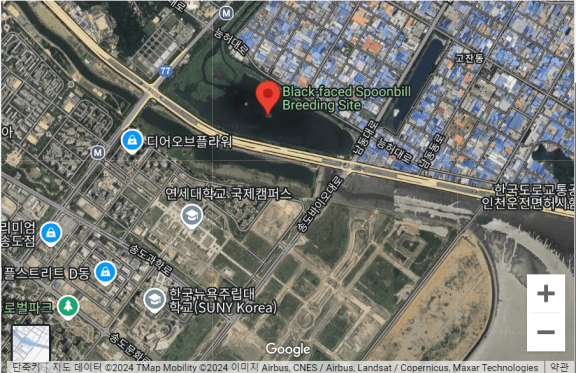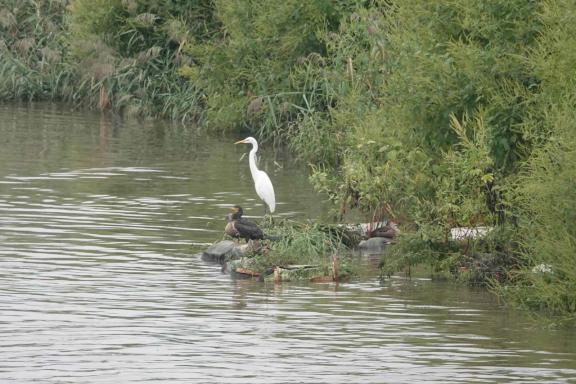IEU Interns Join Conservation Efforts for Endangered Black-faced Spoonbill at Namdong Reservoir
On Thursday, 12 September, interns from the GCF’s Independent Evaluation Unit (IEU) Tsolmon Baatarzorig and Beatrice Mora, along with consultant Tatiana Kan, visited the birdwatching hotspot at the Namdong Reservoir in Incheon, South Korea. This activity was done as part of the IEU Interns’ Day Programme for the month of September. The event was organized by the East Asian-Australasian Flyway Partnership (EAAFP) Secretariat, including several interns and staff from EAAFP.
The event's primary focus was to raise awareness about conservation efforts for the black-faced spoonbill, a migratory waterbird classified by the International Union for Conservation of Nature (IUCN) as an endangered species in East Asia. According to the IUCN Red List, a global indicator of species conservation status, the term ‘endangered’ applies to any species considered to be at a ‘very high risk of extinction in the wild,’ necessitating conservation measures like monitoring and protected breeding areas. The birdwatching event was held at the Incheon Metropolitan City Black-faced Spoonbill Eco Center, located at the Namdong Reservoir, an artificial body of water designed to manage excess water during floods from the adjacent Namdong National Industrial Complex.
Figure 1: Aerial view of the Namdong Reservoir and BFS Eco Center (Google Maps)
Following introductions at the Secretariat’s headquarters, the group proceeded to the Namdong Reservoir for an initial birdwatching session. Participants were informed that due to the approaching migratory season, sightings of the black-faced spoonbill would be unlikely. However, they could observe other endemic bird species, including great cormorants, grey and night herons, great egrets, and spot-billed ducks.
Figure 2: Great egret, spot-billed duck and great cormorant were spotted on the way to the Namdong Reservoir. ⓒ EAAFP
The group also had the opportunity to engage with Ms. Kim Mi Eun, Secretary General of the Incheon Metropolitan City Black-faced Spoonbill Eco Center. She provided insights into the conservation efforts for the black-faced spoonbill and the challenges faced by the reservoir, such as habitat competition and environmental threats.
Most of the visit was dedicated to discussing human environmental impact. In Incheon, chemical waste from nearby factories has historically threatened the reservoir’s ecosystem, and rising water temperatures caused by climate change are leading to an increase in botulinum levels, a lethal toxin for black-faced spoonbill and other wildlife in the Namdong Reservoir.
"I learned how special and rare birds like the Black-faced Spoonbills are, and it deepened my appreciation for bird conservation actions."
– Tsolmon Baatarzorig, IEU Intern
Despite these concerns, participants were encouraged to reflect on society's positive impact on the black-faced spoonbills in recent years. For instance, the recent surge in black-faced spoonbills from only 300 to around 6,000 individuals is mainly due to conservation efforts, such as the creation of new breeding sites and protection from invasive species encroaching on their territory. Those measures have proven to be critical, as this species relies heavily on artificial islands for breeding and is not reproducing naturally.
Human intervention remains crucial at the Namdong Reservoir, as conservationists strive to assist the black-faced spoonbill’s delicate breeding without harming other endemic but non-endangered species, such as cormorants. There was an emphasis on the importance of community involvement in conservation efforts, as citizen birdwatching has been playing a vital role in monitoring the black-faced spoonbill breeding process and increasing awareness of this rare species.
The ongoing efforts at the Namdong Reservoir reflect a broader narrative in conservation: the critical role of human intervention, the importance of citizen engagement, and the urgent need to address the impacts of climate change on biodiversity at a local level. In a world where over 45,300 species, including 12% of bird species, are threatened with extinction, the path to restored biodiversity lies in integrated efforts and the collaboration between local and global communities for more resilient ecosystems.
"Seeing the work at the Namdong Reservoir reminded me of our deep connection with wildlife, even in urban spaces. Conservation action starts very close to home."
– Beatrice Mora, IEU Intern
The IEU would like to thank the East Asian-Australasian Flyway Partnership (EAAFP) Secretariat for organizing this impactful initiative. More information on the EAAFP’s work can be found here: Home - Eaaflyway.
Figure 2: Participants included interns and staff from both GCF IEU and EAAFP. ⓒ EAAFP
About the IEU Internship Programme:
As a part of the larger GCF internship programme, the IEU internship offers young graduates an opportunity to learn and grow by supporting the development and undertaking of evaluations for six months to one year. The IEU’s monthly Interns Day programme allows interns to set aside their usual tasks and explore other areas of the IEU’s work, the GCF, or climate change.


